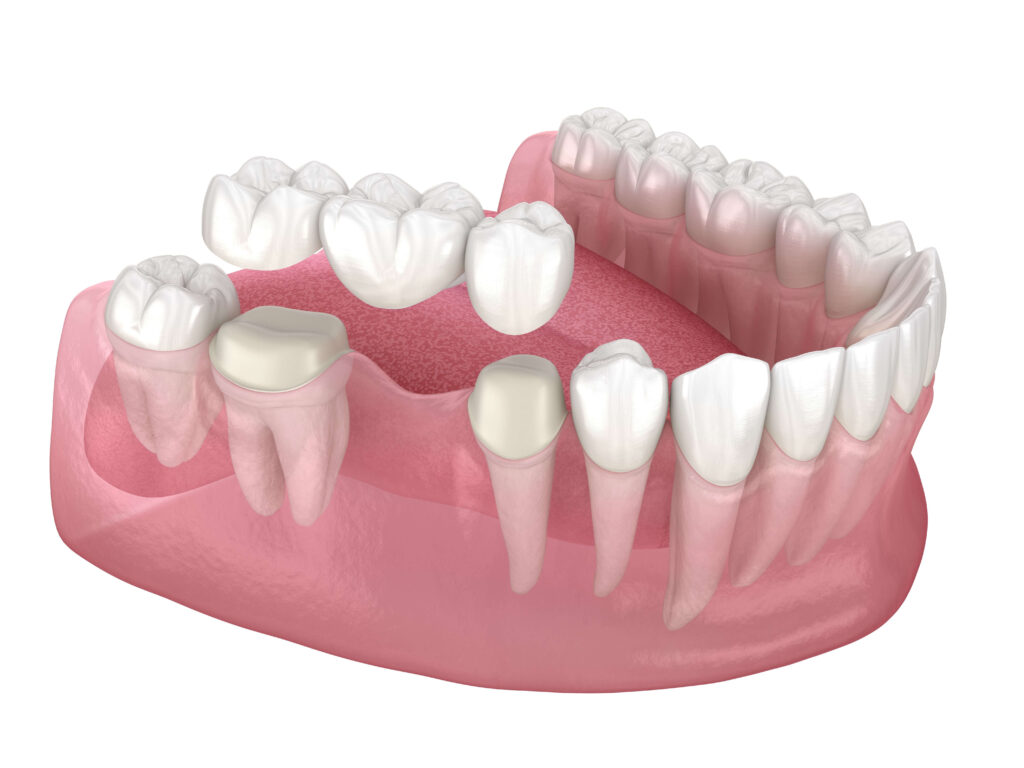What are Dental Bridges?
A dental bridge acts as a replacement tooth after one has been knocked out, naturally fallen out, or removed due to decay or other factors. A bridge is most often made up of two crowns for the teeth on either side of the gap, and a false tooth in the middle to fill the gap. The material used for a dental bridge is usually metal, ceramics/porcelain, or a combination. A dental bridge is an effective alternative to implants or partial dentures.

Why You Might Need a Dental Bridge
A dental bridge is used when a gap in the teeth is present and when remaining teeth are strong enough to support it. A dental bridge can do one of more of the following:
- Restore the appearance of your smile
- Restore your normal bite
- Prevent teeth from shifting into the gap
- Prevent TMJ symptoms due to irregular bite
An examination from Dr. Khan can help you decide if you could benefit from a dental bridge and ensure that you are a good candidate.
What to Expect During Treatment
Your treatment with a dental bridge will require several appointments. During your first appointment, Dr. Khan will prepare your abutment teeth (the teeth on either side of the gap) for crown placement. This can be done under a local anesthetic to ensure your comfort. The outer portion of the tooth and any area of decay will be removed for the crown to fit over it. Next, an impression of the teeth will be made in order to create an exact fit for the bridge. A temporary bridge will be placed while you wait for your permanent one to be created in the lab.
You will have your second appointment once your permanent bridge is ready. Dr. Khan will remove the temporary bridge and place the new one. He will then make any necessary adjustments until you are both happy with the appearance and fit. Dr. Khan might suggest a third appointment to give you a couple of weeks to try out the bridge and ensure a proper bite and fit. The bridge can then be cemented into place for long-lasting use.
Real Patient Testimonials
After Treatment
After your treatment with a dental bridge, you will notice easier biting, chewing, and speaking now that your teeth have been restored. Dr. Khan will provide you with specific instructions on how to care for your dental bridge and will instruct you to use a special floss threader to clean your bridge. With proper care and fit, a dental bridge can last for many years. Good oral hygiene and regular checkups will help to maintain your bridge.
If you have a missing tooth you might be a candidate for a dental bridge. Contact us today to learn more or to schedule your appointment with Dr. Khan.
Dental Bridges Frequently Asked Questions (FAQs)
Are dental bridges permanent?
Why do I need a dental bridge?
How long do dental bridges last?
How long does the dental bridge procedure take?
How should I care for my dental bridge?
Is the dental bridge procedure painful?
How many teeth can a dental bridge replace?
What are the benefits of dental bridges?
Are there any drawbacks of dental bridges?
Is it difficult to remove a dental bridge?
How long does it take for a dental bridge to feel normal?
Is it difficult to clean a dental bridge?
Does food get stuck under a dental bridge?
Can a Waterpik clean under a dental bridge?
Can dental bridges be removed without damage?

Dr. Izaz Khan
Dentist at Ikon Dental Group
Dr. Khan holds a Bachelor's in Physiology and Neurobiology from the University of Connecticut, a Master's in Biomolecular Sciences from Central Connecticut State University, and a dental degree from the University of Connecticut School of Dental Medicine. He completed his residency in comprehensive dental care at the Samuel Stratton VA Medical Center in Albany, NY.